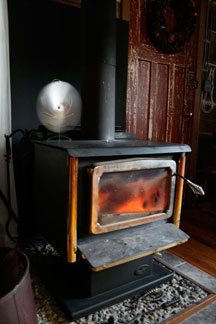
Here in Florida we are still living with opened windows and air-conditioning. For those who live in the north, it is almost time to turn on the heat. In our series of helpful blog posts to help busy mommas, I thought it would be relevant to end the series with an article by a self-sufficient, work at home single mom from the woods of Canada.
Let me introduce you to Victoria Gazeley from British Columbia, Canada. She is living a life of her dreams in a restored log cabin on 6+ acres in coastal British Columbia with her son. Victoria is an oiler and she said the oils are definitely her go-to for health and wellness, not an after-thought.
To get tips and lessons on heating with wood, please head over to read the guest post by Victoria Gazeley below. Remember to connect with her and find out how to live for 3 weeks without groceries.
For your total wellness,
Dr. Mary Starr Carter
the Total Wellness Doc and Mom
*****************************************
Firewood and Wood Stove Basics – Five Lessons for Heating with Wood
By: Victoria Gazeley
Firewood burned in a wood stove is our primary heat source – not just in winter, but year round. We regularly have fires going in the evening here until the end of May.
When we first moved to our rural property, I had so many questions: How much wood do we need for winter? What kind of wood should we burn? How do I prepare it? How do I clean the wood stove? Won’t it make a lot of smoke? As a city girl, I had no clue about building fires or how to use them for heat. But I learned fast. I had to. We’d have been a little chilly otherwise.
The answers would come over the next year, as I learned the finer points of building and maintaining fires and the wood stove that keeps us cozy. I learned that there is no ‘right’ way to build a fire (no matter how many ‘experts’ try to tell you otherwise). That wet wood is to be avoided at all costs. That a hot, clean burn with little to no smoke is the goal. That our loft can get roasting if the fire has been burning all day (and then, of course, that fans are necessary and required to push the warm air around).
I had so many questions about fire as a heat source, and I’m pretty sure lots of other people do too. Especially those who are planning on moving to the country, or have just moved. So I put together my top five lessons for using fire for heat – I hope it’s helpful!
The Top 5 Lessons I’ve Learned About Heating with Wood
1. There is no ‘right’ way to build a fire.
The ‘experts’ will try to tell you otherwise. Like how to plant vegetable seeds, everyone you ask will have a different opinion. So I’ll make it easy for you – try a bunch of different ways and pick the one that’s the least hassle for you and gets the best results. There are some pretty elaborate fire starting methods out there. And some that I still don’t see how they actually get a fire going, let alone quickly. I’m busy – my goal in building a fire is to get it burning fast and to get it burning hot so there’s little to no smoke coming out of the chimney. Then I don’t want to have to think about it for awhile. If you check YouTube, you’ll find all sorts of videos on fire building. Or you can bookmark this fantastic resource: woodheat.org and save yourself the hassle! Find a method that doesn’t look too complicated and try it out. You’ll soon find your favorite. Here’s one I’m going to try next: the top-down fire starting method. I tried it once before and it failed miserably (probably because our wood is cut a little chunky), but I’m willing to give it another try.
2. Better to have too much firewood than not enough.
There are some complicated calculations around for figuring out how much wood you’ll need if you’re heating with with a wood stove. Annoyingly, most articles will start with ‘it depends’. Unfortunately, it really does – on where you live, the temperature that particular winter, how well insulated your house is, what kind of wood you’ll be burning, how efficient your wood stove is, whether or not you’re burning wood full time or just using it to augment your primary heating system during cold snaps… you get the picture.
But if this is any help, we have a 700 square foot house, medium insulated (heritage log cabin with single pane glass augmented with storm windows), burn wood exclusively for heat from October through April in an old, probably inefficient wood stove, and live on the West Coast where temperatures are usually quite mild but damp. Also, I work from home so the fire is burning most of the day. How much wood do we burn? About 2 cords per season (a ‘cord’ is a pile 4′ x 4′ x 8′, densely packed). For us, that’s about 4 or 5 trees’ worth, all dead fall and windfall red alder, maple and hemlock from the previous winter. So for a modest-sized, well insulated home with a new, efficient wood stove burning wood exclusively for heat (with no other major heat sources), most people in the northern States and Canada would be safe with 4 cords or so – but always better to have more, in case it’s a cold winter. (UPDATE November 30, 2013: After a renovation in 2012, we now have about 1000 square feet to heat, including an addition that is nice and open, but the far end being quite far away from the wood stove. The two new rooms have electric baseboard heaters (because the building code requires it), but we don’t use them unless it’s REALLY cold, which last year it wasn’t. Also, the new building is SUPER insulated, so that’s helping with the heat retention. In the 2012/2013 season, we used about 3 cords, from October to April. That’s burning pretty much full time, since I work from home. This year, 2013/2014, we started using the stove in mid-October, from mid-morning to a stoke-up at 10:00 pm or so, and have used about a cord so far).
3. Wood stoves are really versatile – especially in a power outage.
I was just reading an article at Mother Earth News talking about eight different alternate power possibilities to use during power outages. The consensus seemed to be that having a wood stove that could also be used for cooking is the ideal situation. Obviously, if you live in the desert with no wood supply, that’s a bit of a challenge. But for the rest of us, it would seem that having a reasonably efficient wood stove in a rural area is smart insurance. Most winters we have a lot of power outages, and it’s the wood stove that allows us to still have tea, cook our food, and stay warm. We could use our little Kelly Kettle (which is sort of a mini metal rocket stove), but it’s sort of a pain, as it needs to be used outside. Or a camp stove, like some recommend, but during a prolonged power outage, propane and butane canisters sell out extremely quickly (provided the stores still have power!). So a wood stove seems like a good investment. We’ve used ours to boil water, cook eggs, make toast, and keep big meals warm in cast iron pots. I can’t recommend enough having one that has a surface you can cook or heat water on.
4. You NEED fans to push the warm air through your house.
Our old wood stove had a fan that gave up the ghost not long after we moved in. Which was OK, because it was loud – too loud. I wanted to replace it with something quiet, and preferably non-electrical. The solution? A stove-top Ecofan. I got the Airplus model (in nickel) and I love it! It does exactly what it says it does, and more. It’s silent, starts turning as soon as it’s sensors reach a certain temperature, and uses no electricity. Which is great, because in a power outage, you really want your wood stove to be performing at peak efficiency.
We also have a hard-wired ceiling fan at the top of our cathedral ceiling, which pushes the warm air back down into the living area and throughout the house. Obviously, the bigger your house the more you’ll have to think about how the warm air will flow. Last year we had an issue with our bathroom being freezing in the morning, because it’s furthest away from the wood stove. So we used a plug-in oil heater, which kept the bathroom toasty, but racked up a rather large electrical bill. Plus it didn’t work when the power was out (then again, neither does the ceiling fan). Last year, I had the brilliant idea (!) to keep the bathroom door open (except when in use, of course) and voila! The bathroom is warm in the morning. Well, maybe not warm, but at least there are no icicles hanging from the shower head. Problem solved.
5. Good insulation is your friend.
This seems obvious, but you’d be surprised how many people still have single paned windows and big air spaces around their doors. Especially in old houses, which you’ll likely find on properties you might be considering for your modern homesteading adventure. We live in an 80-plus year old log cabin, so spent quite a bit of energy ensuring all the cracks and crevices were filled with insulation and chinked. It does still have single paned windows in the original building, though, so replacing them with triple-glazed wood windows is on our list of eventual renovations. In the meantime, we’ve installed storm windows on all the lower windows. Seems to do the trick.
Will You Heat with Wood this Winter?
These are just a few of the things I’ve learned about heating our home with wood. I think even if we lived in my brand new timber frame dream house, I’d still consider wood as a primary heat source. It’s versatile, renewable (at least in our part of the world), it’s been deemed ‘carbon-neutral‘, and for me, it provides a connection to all my ancestors, who had nothing but wood to heat with.
Your situation will be different, though. Think about your options, and how willing you are to do the work required (sourcing wood, cutting, splitting, piling, hauling, cleaning chimneys, etc.).
If you do decide to heat with wood, chances are you’ll be very happy you did.
If you already heat with wood, do you have any tips to share? Please do in the comments below – newbie homesteaders will thank you!
 Victoria Gazeley lives and works in an 80-plus year old restored heritage log cabin on the wild west coast of British Columbia, Canada. Since the late 1990s, she’s been studying the fine art of rural living, and has been living it since the spring of 2009. Since then, she’s added (with a LOT of help!) a greenhouse, a blueberry patch, various edible plants, a raised bed veggie garden, 10 hens (and 1 character rooster), and most recently, a two-room addition using as many locally sourced materials as possible. You can find her on her blog at modernhomesteading.ca.
Victoria Gazeley lives and works in an 80-plus year old restored heritage log cabin on the wild west coast of British Columbia, Canada. Since the late 1990s, she’s been studying the fine art of rural living, and has been living it since the spring of 2009. Since then, she’s added (with a LOT of help!) a greenhouse, a blueberry patch, various edible plants, a raised bed veggie garden, 10 hens (and 1 character rooster), and most recently, a two-room addition using as many locally sourced materials as possible. You can find her on her blog at modernhomesteading.ca.
Disclaimer: This information is not meant to diagnose, prescribe, treat or cure any illness or disease. It’s strictly for informational, educational, or entertainment purposes ONLY. The products I talk about are not meant to diagnose, prescribe, treat or cure any illness or disease. Any information I give you about them is for informational or entertainment purposes only. They have not been evaluated or approved by the FDA. Please seek the qualified health professional of your choice when making health decisions for yourself, your family and your pets.



